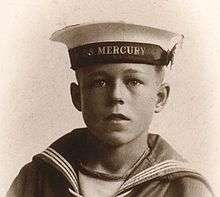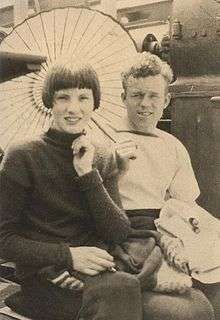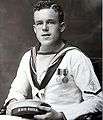Claude Choules
Claude Stanley Choules (/ˈʃuːlz/;[2] 3 March 1901 – 5 May 2011) was an English-born military serviceman from Perth, Western Australia who at the time of his death was the oldest combat veteran of the First World War from England, having served with the Royal Navy from 1915 until 1926. After having emigrated to Australia he served with the Royal Australian Navy, from 1926 until 1956, as a Chief Petty Officer and was a naturalised Australian citizen.[3][4][5] He was the last surviving military witness to the scuttling of the German fleet in Scapa Flow in 1919 and the last surviving veteran to have served in both world wars. At the time of his death, he was the third-oldest verified military veteran in the world and the oldest known living man in Australia.[6] He was the seventh-oldest living man in the world. Choules became the oldest man born in the United Kingdom following the death of Stanley Lucas on 21 June 2010. Choules died at the age of 110 years and 63 days.[7] He had been the oldest British-born man; following his death, that honour went to Reverend Reginald Dean. In December 2011, the landing ship HMAS Choules was named after him, only the second Royal Australian Navy vessel named after a sailor.
Claude Choules | |
|---|---|
 Claude Choules, aged 14 in 1915 | |
| Born | 3 March 1901 Pershore, Worcestershire, England, United Kingdom[1] |
| Died | 5 May 2011 (aged 110 years, 63 days) Salter Point, Perth, Western Australia, Australia |
| Allegiance | |
| Service/ | |
| Years of service | 1915–1956 |
| Rank | Chief Petty Officer |
| Commands held | Acting Torpedo Officer, HMAS Leeuwin Chief Demolition Officer, HMAS Leeuwin |
| Battles/wars | First World War Second World War |
| Awards | British War Medal Victory Medal Ribbon War Medal (1939-1945) UK Ribbon Australian Service Medal (1939-1945) Ribbon Queen Elizabeth II Coronation Ribbon Centenary Medal Australian Defence Medal Naval Long Service and Good Conduct Medal |


Early life
Claude Choules was born in Pershore,[1] Worcestershire, on 3 March 1901 and raised in nearby Wyre Piddle. The son of Harry and Madeline (née Winn), Claude was one of seven children, although two died in early childhood. The surviving siblings were Douglas, Leslie, Phyllis and Gwendoline.[8] His mother left home when Claude was five, returning to the stage as an actress, and he and his older brothers were raised by his father. His older sister Phyllis lived with the family of a paternal uncle, while his younger sister Gwendoline was adopted by the family of a paternal aunt.[9] Claude and his older brothers went to Pershore National Boys' School, though Douglas (born 1893) and Leslie (born 1894) emigrated to Western Australia in 1911.[10]
Choules was 13 on the outbreak of the First World War, and the family received letters from Douglas[11] and Leslie[12][13][14] who had joined the Australian Imperial Force and landed at Anzac Cove during the Gallipoli Campaign. Choules was able to leave school when he turned 14, at which point he attempted to enlist in the army as a bugler boy but was rejected as he was too young.[15]
Naval training
Choules' father then arranged for him to train to join the navy instead, and in April 1915, at age 14, he joined the nautical training ship TS Mercury.[16]
This training ship was moored on the River Hamble, near Southampton, Hampshire, and had a dormitory ship called HMS President that had previously been HMS Gannet.[17] The commander of the Mercury training site was the cricketer C. B. Fry, and Choules' time there included trips to Netley Hospital as part of the Mercury's dancing team.[18] The examinations taken by Choules following his training on the Mercury qualified him to attend the advanced class on the naval training ship HMS Impregnable situated at the Devonport naval base in Plymouth. Choules transferred there on 10 October 1916, for what was to be the final stage of his training before joining the Royal Navy's Grand Fleet.[19]
Naval service
On 20 October 1917, Choules joined the battleship Revenge, which was the flagship of the First Battle Squadron and stationed at Scapa Flow in the Orkney Islands. While serving aboard it, Choules saw action against German zeppelins,[20] and witnessed the surrender of the German Imperial Navy at the Firth of Forth in 1918, ten days after the Armistice, as well as witnessing the scuttling of the German fleet in Scapa Flow.[21]
In 1926, along with 11 other Royal Navy senior sailors, Choules travelled to Australia on loan as an instructor at Flinders Naval Depot. He travelled in SS Diogenes on a six-week voyage from London to Melbourne, and it was on this voyage that he met his future wife Ethel Wildgoose who was travelling to Australia to carry out work for the Victoria League.[22] Choules decided to transfer permanently to the Royal Australian Navy (RAN) after sampling and agreeing with the Australian way of life.[23]
He took his discharge from the RAN in 1931, but remained in the reserves and rejoined the RAN in 1932 as a chief petty officer torpedo and anti-submarine instructor. He never returned to England after leaving.[24]
During the Second World War, Choules was the acting Torpedo Officer at HMAS Leeuwin, the naval base at Fremantle, Western Australia,[25] and also served as the Chief Demolition Officer on the western side of the Australian continent.[21] He was tasked with sabotaging Fremantle harbours and related oil storage tanks in the event of a Japanese invasion.[25] Choules was also responsible for dealing with the first German mine to wash up on Australian soil during the war, near Esperance, Western Australia.[25]
Choules remained in the RAN after the Second World War and transferred to the Naval Dockyard Police (NDP) to allow him to remain in service until 1956, as retirement from the RAN for ratings in those days was at age 50, while personnel could serve until 55 years old in the NDP.[26][27]
Personal life
Choules and his wife Ethel were married for 76 years, until her death at age 98.[26] Choules shunned celebrations of the Armistice, because he was against the glorification of war.[28] His autobiography The Last of the Last was first published in Perth in 2009,[29] followed by an annotated edition for UK readers in 2010.
On 6 August 2009, although almost blind and deaf, he was still mentally active and gave a television interview.[30]
In late April 2010, Choules's daughter Daphne Choules-Edinger reported that his health was declining and he could no longer give interviews.[31] He celebrated his 110th birthday in March 2011.[32] In the final years of his life, he resided at Gracewood Hostel in Salter Point, a suburb of Perth.
Media appearances
Claude Choules appeared in the BBC documentaries The Last Tommy (2005) and Harry Patch – The Last Tommy (2009). After his death, Australian Prime Minister Julia Gillard stated, "Mr Choules and his generation made a sacrifice for our freedom and liberty we will never forget".[33]
Death and funeral
Choules died on 5 May 2011.[34] He was survived by three children, 11 grandchildren, 22 great-grandchildren and three great-great grandchildren.[26] He was given a naval funeral in Fremantle, Western Australia on 20 May 2011. Guests included the West Australian Premier Colin Barnett, state Opposition Leader Eric Ripper and federal Defence Minister Stephen Smith, who gave a reading during the service. Choules's son Adrian gave the eulogy.[35]
On 13 December 2011, the former Royal Fleet Auxiliary landing ship Largs Bay was commissioned into the Royal Australian Navy as HMAS Choules.[36] The decision to name the ship after Claude Choules came about because of his status as the last surviving veteran of World War I; the naming recognises the service of enlisted sailors as part of celebrations of the navy's centenary (the ship is only the second vessel named after a sailor), and also acknowledges the ship's previous service under British control (Choules served in both the Royal Navy and the Royal Australian Navy during his career).[36][37]
Choules was the last surviving male veteran of World War I and the last surviving veteran who saw active service. His death left Florence Green (19 February 1901 – 4 February 2012) as the last surviving veteran.[38]
Legacy
On 10 April 2014, the Pershore Town Council decided to honour Choules by naming a street ("Claude Choules Close") after him, in recognition of the fact that he was born in the town.[39]
Awards
In November 2009, Choules became the oldest recipient of the Australian Defence Medal. (The medal was established in 2006 to recognise members of the Australian Defence Force who have served for more than four years after 3 September 1945).[40][41]
He was also awarded the British War Medal 1914–18, the Victory Medal 1914–18, the War Medal 1939–45, the Australia Service Medal 1939–45, the Queen Elizabeth II Coronation Medal, the Centenary Medal and the Royal Navy Long Service and Good Conduct Medal with Clasp.[40][41][42][43]
![]()
![]()
![]()
![]()
![]()
![]()
![]()
![]()
| British War Medal | ||
| Victory Medal 1914–18 | ||
| War Medal 1939–45 | ||
| Australia Service Medal 1939–45 | ||
| Queen Elizabeth II Coronation Medal | 1953 | |
| Centenary Medal | 2001[42] | |
| Australian Defence Medal | 2009[40] | |
| Royal Navy Long Service and Good Conduct Medal | with clasp to denote 30 years' service |
See also
- List of last surviving World War I veterans
- List of Australian supercentenarians
 1917
1917 1918
1918 c.1925
c.1925 c.1935
c.1935 1936
1936
Notes
- "1911 census". Archived from the original on 23 July 2011. Retrieved 6 May 2011.
- Last known World War I combat veteran dies, 5 May 2011, National Public Radio, www.npr.org
- "Claude Choules: the Last of the Last". The Telegraph. 5 May 2011. Retrieved 5 May 2011.
- "Claude Choules: a place in history". The Telegraph. 5 May 2011. Retrieved 5 May 2011.
- "Obituary: Chief Petty Officer Claude Choules". The Telegraph. 5 May 2011. Retrieved 5 May 2011.
- Agence France-Presse (27 July 2009). "Claude Choules says WWI was 'boring'". The Australian. Archived from the original on 25 May 2012. Retrieved 2 August 2008.
Mr Choules was informed by his 80-year-old daughter Anne Pow over the weekend that the death of 111-year-old Harry Patch, Britain's last soldier who fought in the Great War's infamous trenches, had made him the country's sole survivor.
- "Australia's last WWI veteran dies ABC News". Australian Broadcasting Corporation. Retrieved 6 May 2011.
- Choules 2010, p. 13.
- Choules 2010, p. 15.
- Choules 2010, pp. 18–19.
- Claude's brother Private Douglas Victor Choules, aged 21, joined on 3 September 1914 (Service number: 522), was assigned to "E" Company of 11 Infantry Battalion and embarked on the HMAT Ascanius at Fremantle on 2 November 1914. (Embarkation Roll) He named his brother Leslie as his next of kin. (Nominal Roll)
- Claude's brother Private Henry Leslie Choules, aged 19, joined on 29 January 1915 (Service number: 1794), was assigned to 4 Infantry Brigade of 16 Infantry Battalion and embarked on the HMAT Argyllshire at Fremantle on 19 April 1915. (Embarkation Roll) He was awarded the Military Medal on 18 June 1917. (It's an Honour Archived 13 January 2018 at the Wayback Machine) He held the rank of sergeant when he returned to Australia on 28 February 1919. (First World War Nominal Roll Page – AWM133, 09-077)
- There was also a Private Norman William Choules, aged 27, who joined on 28 October 1915 (Service number: 4470), was assigned to 11 Infantry Battalion (14th Reinforcements), and embarked on the HMAT Miltiades at Fremantle on 12 February 1916. His next of kin was his wife, Mrs M I Choules of Palmyra, Fremantle. (Embarkation Roll) He died of wounds on 10 May 1917, aged 29, and was buried at the Grevillers British Cemetery in France. He was the son of William and Mary Ann Choules; husband of M. I. Choules. Born at Palmyra, Western Australia. (Roll of Honour)
- Claude Choules' obituary in The Telegraph notes: "His sister and his two older brothers, Henry and Douglas, emigrated to Western Australia, where the two boys joined the Australian Imperial Force. They survived the fighting at Gallipoli and in France. ... But three other members of the family left their names on Wyre Piddle's First World War memorial."
- Choules 2010, pp. 30–32.
- Choules 2010, p. 32.
- Choules 2010, p. 41.
- Choules 2010, pp. 42–43.
- Choules 2010, p. 44.
- "Obituary: Claude Choules". BBC News. 5 May 2011. Retrieved 28 January 2020.
- Booth, Gary. "500 km by bike to demolish Albany". Navy News. Archived from the original on 3 February 2008. Retrieved 6 July 2007.
- Choules 2010, p. 115.
- Carman, Gerry (7 May 2011). "Last post for final veteran of WWI". The Sydney Morning Herald. Retrieved 11 May 2011.
- "WWI survivor celebrates his 107th birthday". ABC Perth. Archived from the original on 5 November 2012. Retrieved 4 March 2008.
- Conway, Doug (6 May 2011). "Age no longer wearies last warrior of two world wars". Sydney Morning Herald. Retrieved 1 June 2011.
- Batcheler, Alison (3 February 2008). "At 106, the secret to long life is: Don't die". WA News. Archived from the original on 30 September 2007. Retrieved 3 February 2008.
- "A lesson in Longevity" (PDF). The Baptist Advocate. Archived from the original (PDF) on 3 February 2008. Retrieved 3 February 2008.
- Emma Alberici (12 November 2009). "Merkel helps French mark Armistice Day". Australian Broadcasting Corporation. Retrieved 6 May 2011.
- Linda Cann (2 March 2010). "Last WW1 veteran in Australia, Claude Choules, turns 109". Perth Now. Retrieved 6 May 2011.
- Five videos Archived 15 November 2009 at the Wayback Machine, 6 August 2009, Interview with Claude Choules, ITV News, www.itnsource.com
- Tate, Lee (24 April 2010). "Final battle nears for last of Great War greats". The Age. Australia. Retrieved 26 April 2010.
- "110th birthday for proud veteran". Worcesternews.co.uk. 4 March 2011. Retrieved 6 May 2011.
- Perpitch, Nicolas (6 May 2011). "Veteran Claude Choules's death breaks last link to World War I". The Australian. Retrieved 6 May 2011.
- "Obituary: Claude Choules". BBC News. Biritish Broadcasting Corporation. 4 May 2011. Retrieved 4 May 2011.
- "Touch of humour at last WWI veteran's farewell". The Canberra Times. 21 May 2011. Archived from the original on 20 November 2011. Retrieved 23 May 2011.
- "HMAS Choules commissioned in honour of veteran". ABC News. Australian Broadcasting Corporation. 13 December 2011. Retrieved 13 December 2011.
- Griggs, Ray (13 August 2011). "Naming of Ex RFA Largs Bay – HMAS Choules". Royal Australian Navy. Archived from the original on 6 December 2011. Retrieved 14 December 2011.
- Norfolk woman identified as WWI survivor, 19 January 2010, BBC News
- Nigel Slater (18 April 2014). "War veteran honoured by town". Evesham, Worcestershire, UK: Evesham Observer. Archived from the original on 23 April 2014. Retrieved 23 April 2014.
- "Claude Choules". HMAS CANBERRA FFG-02 site. 6 May 2011. Retrieved 7 May 2011.
- Australian Government, Defence Honours and Awards, Issue 9 (April 2010) and Issue 12 (April 2012).
- Centenary Medal Archived 29 November 2014 at the Wayback Machine, 1 January 2001, It's an Honour
- Choules's medals. Photo taken prior to addition of Australian Defence Medal. Copyright REUTERS
References
- Choules, Claude (2010). The Last of the Last: The Final Survivor of the First World War (2nd ed.). Edinburgh & London: Mainstream Publishing. ISBN 978-1-84596-705-5. Archived from the original on 11 August 2011. Retrieved 31 August 2012.CS1 maint: ref=harv (link)
Further reading
- Choules, Claude (2009). The Last of the Last: His Autobiography (1st ed.). Carlisle: Hesperian Press. ISBN 9780859054805.
External links
| Wikimedia Commons has media related to Claude Choules. |
- Imperial War Museum Interview
- WWI veteran Claude has a 108th birthday date
- View the Royal Navy service record (1916–1926) of Claude Choules
- Catalogue entry, UK National Archives
- Five videos, 2009 interview with of Claude Choules, ITV News
- Last male WWI veteran dies, 5 May 2011, ABC
- Copyright photos:
- Claude Choules receiving the Australian Defence Medal;
- At Monument Hill War Memorial in Fremantle: Claude and familyClaude
- An active Claude at 105
- 100-year-old Claude with his wife Ethel, 97, celebrating their 75th wedding anniversary